| |
|
A HEALTHY FOREST often requires
some active management. An enlightened manager may wish to remove
small numbers of logs from the forest without damaging what is
left behind:
- to salvage individual blowdown
trees as an ordinary periodic chore
- to carry out a judicious timber
thinning for the benefit of the remaining trees in the stand
- to undertake a systematic smallwood
harvest as a modest commercial venture, while preserving most
of the best trees.
Logs are usually large and heavy
relative to people. Major challenges when moving logs from the
forest include lifting great weights on unpredictable terrain,
overcoming friction, protecting residual vegetation, and assuring
personal safety at all times. Large-scale loggers overwhelm these
problems, often recklessly when operating on other people's property,
with massive and expensive mechanized equipment that can create
serious environmental problems by damaging vegetation and soil.
Large equipment operators are also inclined to remove the largest
and best trees, which is frequently inadvisable for the continued
prosperity of the forest. There are many advantages in using
smaller and less expensive log-moving equipment, but such equipment
is just now becoming available in this country.
The devices described below are
suitable for small-scale, low-impact logging in the San Juans,
where parcels are small, tree growth is slow, soils are vulnerable
to long-term damage, and the prominent commercial loggers are
irresponsible. The implements can be owned and operated by a
private landowner, or shared by an association of forest owners,
or by an entrepreneur embarking on a responsible, commercial
enterprise of "residential" forest management (such
a small business could provide a valuable and lucrative service
that is badly needed in this county). Logs that are extracted
from a stand using these implements may yield useful local products
such as firewood, poles, or on-site milled lumber, or they may
be sold as logs and transported off site.
Anyone engaged in woodlot management,
tree falling, and log handling should be familiar with the traditional
tools of the trade: chainsaws, limb-pruning handsaws, peavies,
chains, chockers, nylon straps, cables, snatch blocks, come-alongs,
log splitters, chippers, etc. These and many other items are
available from general supply catalogs (see references at end
of page), local equipment suppliers and rental stores, logging
specialists such as Wood's Logging Supply, Inc., in Sedro-Woolley,
WA, and second-hand outlets such as Pat's in Burlington, WA.
Warning! Felling trees can be particularly dangerous.
This may be one task that a landowner specifically out-sources
to a contract faller. Once a tree is down, limbing, log extraction,
and utilization can be done by the landowner with the following
equipment or by a worker in his or her employ. It cannot be stressed
too strongly that whoever does the actual work must give full
attention to protective gear and safe operating procedures.
|
|
|
|
HAULING LOGS BY HAND
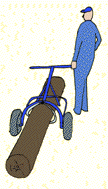 ELEVATING A LOG onto a simple wheeled
apparatus is a basic first step in facilitating log transport.
A small, human-powered logging arch can hoist a log onto two
wheels by lever action or hand-operated winch. The "Blue
Ox" (at left is) sold for about $350 by general suppliers.
The similar "Junior Arch" by Future Forestry Products
(the manufacturer offers a video) has a more generous capacity
and costs about $430. In either case, the hauling arch is wheeled
into the forest and positioned over the center of a log; tongs
grab the log, which is then lifted between the wheels for transport
by lowering the handle. Such arches handle logs up to about 15
inches in diameter and more than 12 feet long, which can weigh
several hundred pounds. ELEVATING A LOG onto a simple wheeled
apparatus is a basic first step in facilitating log transport.
A small, human-powered logging arch can hoist a log onto two
wheels by lever action or hand-operated winch. The "Blue
Ox" (at left is) sold for about $350 by general suppliers.
The similar "Junior Arch" by Future Forestry Products
(the manufacturer offers a video) has a more generous capacity
and costs about $430. In either case, the hauling arch is wheeled
into the forest and positioned over the center of a log; tongs
grab the log, which is then lifted between the wheels for transport
by lowering the handle. Such arches handle logs up to about 15
inches in diameter and more than 12 feet long, which can weigh
several hundred pounds.
A small logging arch can also
be used in some ground-level cable-yarding operations for raising
the leading end of a log off the forest floor as the log is being
removed from the woods; in such a case the operator manipulates
the cable winch, not the arch. Logging arches or haulers can
also be used to lift the trailing end of a log while the leading
end is elevated by some other device, such as a tractor's three-point
hitch (five figures below), in order to tow it along a prepared
road or trail.
|
|
CHAINSAW
SKIDDING
 ACQUIRING
LOW-COST POWER to drag logs in confined spaces is always problematical.
Some assistance can be provided by a Lewis chainsaw winch
(see right), which is available from general suppliers for about
$575. When substituted for the chain bar (or when permanently
fixed to a dedicated chainsaw engine), it is a portable power
winch with some utility, especially in conjunction with a snatch
block. It is, however, potentially very hazardous to the operator;
even at the best of times it is hard on the engine and the operator. ACQUIRING
LOW-COST POWER to drag logs in confined spaces is always problematical.
Some assistance can be provided by a Lewis chainsaw winch
(see right), which is available from general suppliers for about
$575. When substituted for the chain bar (or when permanently
fixed to a dedicated chainsaw engine), it is a portable power
winch with some utility, especially in conjunction with a snatch
block. It is, however, potentially very hazardous to the operator;
even at the best of times it is hard on the engine and the operator.
|
|
| |
|
SMALL
MECHANIZED YARDING
THERE IS A growing demand for
medium-sized, towable logging arches. At least two are available
that are designed to be pulled by ATVs (All-Terrain Vehicles
-- 4-wheel drive, 300-400 cc, which sometimes can be fitted with
special hitches, protective cage, and front-end counterweights).
The ATV arch, costing about $1475 from Future Forestry Products,
is manually positioned over one or more logs that are then hoisted
off the ground using
|
|
|
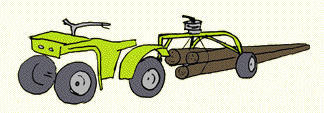 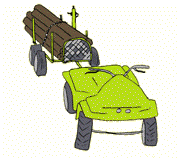 |
|
|
| |
|
an
attached hand-operated winch (above, left). A self-loading arch
is also available from NovaJack (see references). Both products
are demonstrated in videotapes available upon request from the
makers. Instead of pulling a small arch, ATVs can also haul logs
on an ATV-pulled timber trailer. NovaJack's bogie trailer comes
with either an accessory loading pivot or a mast-mounted winch
to help load the logs (above, right). |
|
|
| |
|
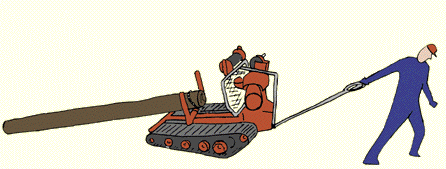
|
|
|
| |
|
The
9-HP Iron Horse Pro from West Coast Logging Shows or Tilton Equipment
is equipped with either a manual or power winch and costs about
$10,000. It can be used alone or with a timber trailer
and a variety of other accessories. A manufacturer's videotape
illustrates its versatility, maneuverability, excellent traction,
and low impact on soil and vegetation. The Iron Horse would be
an ideal log hauler for many small forest parcels in the San
Juans. |
|
|
| |
|
USING A FARM TRACTOR |
|
|
| |
|

|
|
|
| |
|
AN ACCESSORY LOGGING winch can
transform an ordinary farm tractor into a very effective, powerful
and relatively low-impact logging machine. Finnish-made Farmi
logging winch powered by the tractor's PTO are available through
Barnett or Scholten's for about $2600 from the regional dealer,
Western Woodlands (below). Another logging winch made by NovaJack
is powered by hydraulic drive. Either accessory winch is controlled
by the operator standing off to the side or, less advisedly,
from the cab. The winch allows the tractor to remain out of the
forest proper, say on a defined road or trail, thereby reducing
soil compaction; because the blade of the winch's butt plate
is lowered onto the ground and the cabled load drives the blade
downward, stress on the tractor is reduced.
While using a logging winch with
a tractor, a frontend bucket loader is useful as a counterbalance.
Though primarily used for skidding, a logging winch can also
aid in directional tree falling or freeing a leaning tree. In
the latter application it is imperative to use a snatch block
to pull the falling tree away from the tractor (rather than toward
it). When skidding a log with any winch, it is often wise to
place a snatch block high into a stategically located tree; this
lifts the leading end of the log off the ground and reduces gouging.
A snatch block can also re-direct the log away from obstacles.
Digging-in can be further reduced by attaching a skidding pan
or cone; skidding pans made of fiberglas or plastic, though available,
are not as durable as an old car hood, for example from a Volkswagen
Beetle. As previously mentioned, friction can be reduced by elevating
the log with a whelled hauler or arch.
|
|
|
| |
|
Once a log has been extracted
from the woods, assuming a defined trail or roadway exists, it
can be transported without skidding and gouging the trail by
suspending the trailing end on a wheeled device such as a Blue
Ox and elevating the leading end by a cable of a logging winch
or by chain attached to the tractor's hydraulic lifting bar (see
above).
|
|
|
| |
|
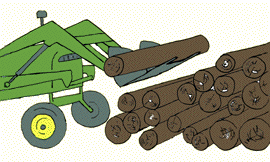 DECKING (stacking) DECKING (stacking)
A FARM TRACTOR can be made even
more versatile for small-scale logging by fitting logging tines
onto its frontend loader. This addition allows shorter logs to
be transported crosswise and longer logs to be lifted and posiutioned
onto log piles.
|
|
|
| |
|
ON-SITE MILLING
ONCE LOGS HAVE been extracted
from the forest they may be transported and marketed as such,
however small-scale operations often do not generate sufficient
volume to attract a commercial trucker or mill. Alternatively,
a small volume of logs can be rough-milled on site by hiring
a mobile sawmill with its operator, such as San Juan Mobile
Sawmill.
If milling is contemplated, prearranging
a suitable operational layout is important. It is also essential
to accurately assess the market or private need for cut lumber.
If the logs were previously stacked on a level ground or a slight
up-slope, they can easily be rolled one at a time toward the
mill. Sites for stacking the cut lumber for air-drying under
tarps or in an open shed should be prearranged with care. A safe
and orderly work site can be maintained around the mill. Spread
tarps can faciliate collection and removal of the sawdust that
is generated by the milling operation. Collected sawdust can
be converted into a useful soil amendment by composting it with
a source of nitrogen, such as manure.
|
|
|
| |
|
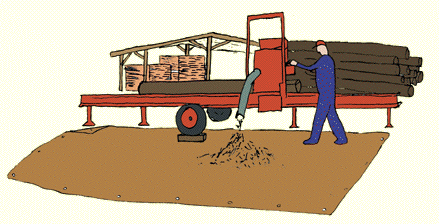 |
|
|
| |
|
FIREWOOD
PRODUCTION
|
|
|
| |
|
SMALL LOGS, TOP logs, larger
branches and mill slabs can all be used for firewood. Logs need
to be split and much physical exertion can be expended in bucking
and handling the rounds, let alone in the splitting itself. A
hydraulic log splitter (about $1000) and the arrangement shown
below can make the job much easier.
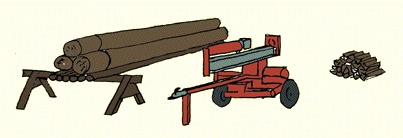
First, 12-foot supporting
rails are fastened to sawhorses at a height that is comfortable
for bucking. The splitter is positioned alongside. Then, logs
are transported near the bed of rails and bucked into intermediate
lengths that are easily lifted onto the bed; assuming that the
goal is standard 16-inch firewood lengths, the logs should be
bucked into multiples of 16 inches, for example to 8 or 12 feet
in length.) A
few of these intermediate-length logs are stacked onto the elevated
bed and chain-sawed down to 16-inch long rounds. This operation
is best done from the side opposite the logsplitter; wood chips
can be collected on tarps. From the other side of the bed, individual
rounds can be conveniently lifted to the splitter. Split firewood
is then tossed well away from the operation for later stacking
and seasoning. Collected wood chips can be salvaged as
a useful by-product, namely garden mulch.
|
|
|
| |
|
GENERAL SUPPLIERS
Bailey's, P.O. Box 550, 44650
Hwy. 110, Laytonville, CA 95454. 1-800-322-4539
Ben Meadows Company, 3589 Broad Street, Atlanta, GA 30341. 1-800-628-2068
Forestry Suppliers, Inc., P.O. Box 8397, Jackson, MS 39284- 8397.
1-800-647-5368
Terra Tech, Inc., P.O. Box 5547, Eugene, OR 97405-0547. 1-800-
321-1037
SPECIALTY SUPPLIERS
Barnett Implement, P.O. Box 666,
Mount Vernon, WA 98273. 1-800-453-9274
Future Forestry Products, Inc., P.O. Box 1083 Willamina OR 97396-1083.
1888 258 1445; contact@futureforestry.com;
www.futureforestry.com
San Juan Mobile Sawmill, P.O. Box 3133, Friday Harbor, WA 98250.
360-378-6186
Scholten's Equipment, Inc., 953-B Green Road, Burlington, WA
98233. 1-800-726-8081
Tilton Equipment, 4575 Chatsworth Street N, St. Paul, MN 55126.
612-483-5488
NovaJack, 375, Courcelette Street,
Sherbrooke, Quebec, Canada, J1K 2B6. Toll free from Canada and
USA : (800) 567-7318 www.novajack.com
West Coast Logging Shows, Box 1035, Squamish, B.C. V0N 3G0, Canada.
604-898-9493
Western Woodlands Equipment, P.O. Box 2991, Eugene, OR 97402.
541-302-8223
|
|
|
| |
|
Return to fOREST iNFO Home
Tom Schroeder
tom@rockisland.com
|
|
|



 ELEVATING A LOG onto a simple wheeled
apparatus is a basic first step in facilitating log transport.
A small, human-powered logging arch can hoist a log onto two
wheels by lever action or hand-operated winch. The "Blue
Ox" (at left is) sold for about $350 by general suppliers.
The similar "Junior Arch" by Future Forestry Products
(the manufacturer offers a video) has a more generous capacity
and costs about $430. In either case, the hauling arch is wheeled
into the forest and positioned over the center of a log; tongs
grab the log, which is then lifted between the wheels for transport
by lowering the handle. Such arches handle logs up to about 15
inches in diameter and more than 12 feet long, which can weigh
several hundred pounds.
ELEVATING A LOG onto a simple wheeled
apparatus is a basic first step in facilitating log transport.
A small, human-powered logging arch can hoist a log onto two
wheels by lever action or hand-operated winch. The "Blue
Ox" (at left is) sold for about $350 by general suppliers.
The similar "Junior Arch" by Future Forestry Products
(the manufacturer offers a video) has a more generous capacity
and costs about $430. In either case, the hauling arch is wheeled
into the forest and positioned over the center of a log; tongs
grab the log, which is then lifted between the wheels for transport
by lowering the handle. Such arches handle logs up to about 15
inches in diameter and more than 12 feet long, which can weigh
several hundred pounds. ACQUIRING
LOW-COST POWER to drag logs in confined spaces is always problematical.
Some assistance can be provided by a Lewis chainsaw winch
(see right), which is available from general suppliers for about
$575. When substituted for the chain bar (or when permanently
fixed to a dedicated chainsaw engine), it is a portable power
winch with some utility, especially in conjunction with a snatch
block. It is, however, potentially very hazardous to the operator;
even at the best of times it is hard on the engine and the operator.
ACQUIRING
LOW-COST POWER to drag logs in confined spaces is always problematical.
Some assistance can be provided by a Lewis chainsaw winch
(see right), which is available from general suppliers for about
$575. When substituted for the chain bar (or when permanently
fixed to a dedicated chainsaw engine), it is a portable power
winch with some utility, especially in conjunction with a snatch
block. It is, however, potentially very hazardous to the operator;
even at the best of times it is hard on the engine and the operator.





 DECKING (stacking)
DECKING (stacking)
